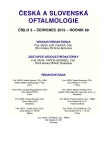Comparison of Central Corneal Chickness and Keratometric Measurements using the Scheimpflug HR Imaging System, Laser Interferometry, Automatic Keratometry and Ultrasound Pachymetry
Authors:
P. Pašová 1,2; K. Skorkovská 1; J. Michálek 3
Authors‘ workplace:
Klinika nemocí očních a optometrie LF MU, Fakultní nemocnice u sv. Anny, Brno, přednosta doc. MUDr. Svatopluk Synek, CSc.
1; Oční centrum Palánek, s. r. o., Vyškov
2; Ústav matematiky, Fakulta strojního inženýrství, VUT, Brno
3
Published in:
Čes. a slov. Oftal., 68, 2012, No. 3, p. 116-119
Category:
Original Article
Overview
Introduction:
The aim of our study was to compare keratometry and central corneal thickness measurements obtained with three different ophthalmic devices and to decide if they can be used interchangeably in clinical practice.
Methods:
43 healthy persons were included in the study (29 women and 14 men, average age 25 ± 3.5 years). Central corneal thickness (CCT) was measured with the Scheimpflug HR imaging system (Pentacam), Allegro BioGraph and with ultrasound pachymetry (RXP OcuScan). Keratometry in two main meridians of the cornea (K1, K2) was measured with Pentacam, Allegro BioGraph and automated keratometry.
Results:
The mean difference in K1-readings was 0.01 ± 0.31 D for BioGraph vs. automated keratometry, 0.06 ± 0.23 D for BioGraph vs. Pentacam and 0.05 ± 0.34 D for automated keratometry and Pentacam. The mean difference in K2-readings was 0.29 ± 0.45 D for BioGraph vs. automated keratometry, 0.11 ± 0.28 D for BioGraph vs. Pentacam and 0.19 ± 0.44 D for automated keratometry and Pentacam. The interdevice differences were in all cases statistically significant (p < 0.05). The mean difference in CCT was 4.57 ± 7.84 μm for BioGraph vs. ultrasound, 4.33 ± 7.55 μm for BioGraph vs. Pentacam and 8.90 ± 7.49 μm for ultrasound vs. Pentacam. The interdevice differences in CCT were also statistically significant (p < 0.05).
Conclusion:
Our results suggest that the measurements of keratometry and CCT may differ significantly between the tested machines and therefore should not be used interchangeably in clinical practice.
Key words:
keratometry, pachymetry, CCT, Pentacam, BioGraph
Sources
1. Beutelspacher, SC., Serbecic, N., Scheuerle, AF.: Measurement of the cetral corneal thickness using optical reflectometry and ultrasound. Klin Monbl Augenheilkd, 2011; 228: 815–818.
2. Elbaz, U., Y. Barkana, et al.: Comparison of Different Techniques of Anterior Chamber Depth and Keratometric Measurements. Am J Ophthalmol, 2007; 143: 48–53.
3. Hashemi, H., E. Jafarzadehpur, et al.: Comparison of corneal thickness measurement with the Pentacam, the PARK1 and an ultrasonic pachymeter. Clin Exper Optometry, v tisku.
4. Lee, Y. G., J. H. Kim, et al.: Comparison between tonopachy and other tonometric and pachymetric devices. Optom Vis Sci, 2011; 88: 843–9.
5. Módis, L. Jr, Szalai, E., Németh, G., Berta, A.: Reliability of the Corneal Thickness Measurements with the Pentacam HR Imaging System and Ultrasound Pachymetry. Cornea, 2010; Dec 4.
6. Nissen, J., Hjortdal, JO., Ehlers, N., et al.: A clinical comparison of optical and ultrasonic pachymetry. Acta Ophthalmol 1991; 69: 659–66.
7. Refai, T. A.: Agreement between pentacam and opd videokeratography in corneal power and axis assessment. Australian J Basic Appl Sci, 2010; 4: 5135–5143.
Labels
OphthalmologyArticle was published in
Czech and Slovak Ophthalmology

2012 Issue 3
Most read in this issue
- Current Overview of the Diabetic Macular Edema
- Comparison of Central Corneal Chickness and Keratometric Measurements using the Scheimpflug HR Imaging System, Laser Interferometry, Automatic Keratometry and Ultrasound Pachymetry
- Psychometric Validation of Visual Function Questionnaire (NEI VQF-25) under Local Conditions in Slovakia, E.U.
- Complications of Deep Nonpenetrating Sclerectomy
